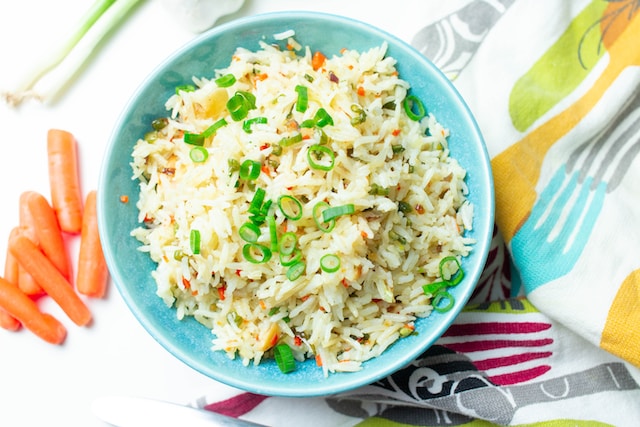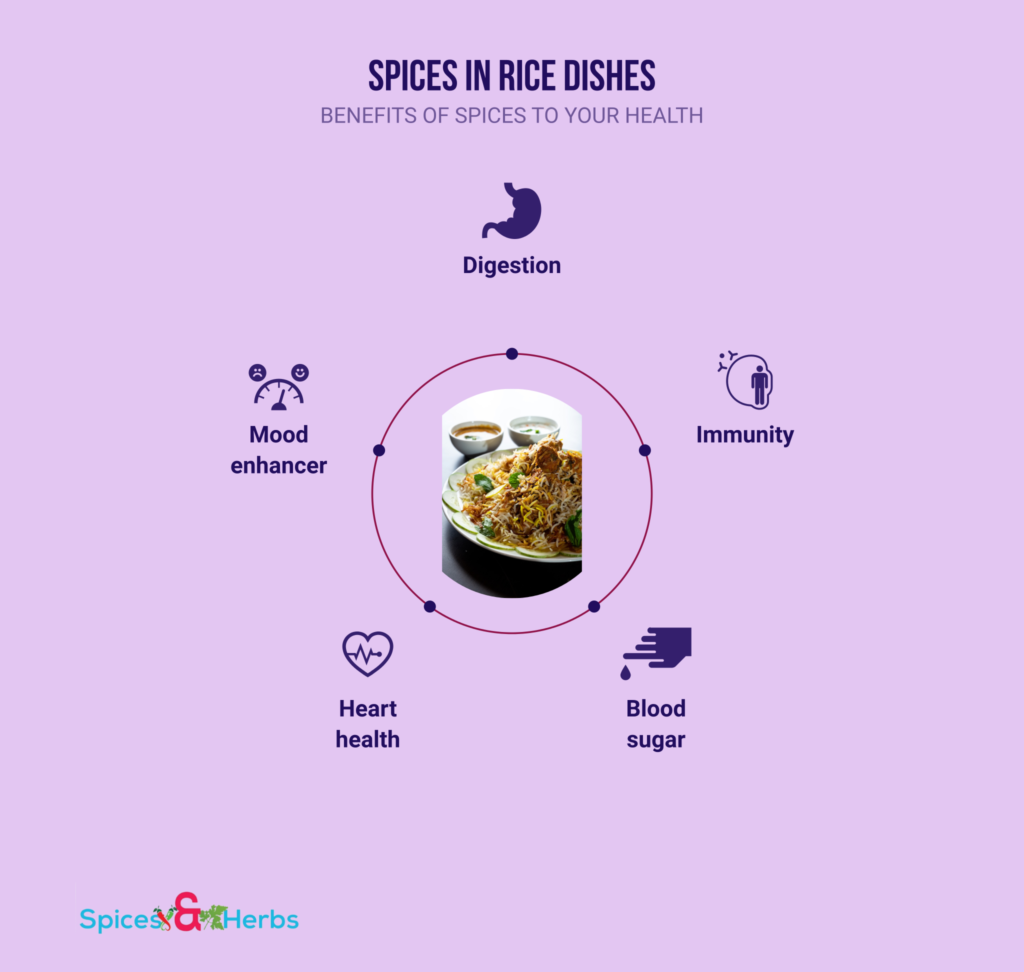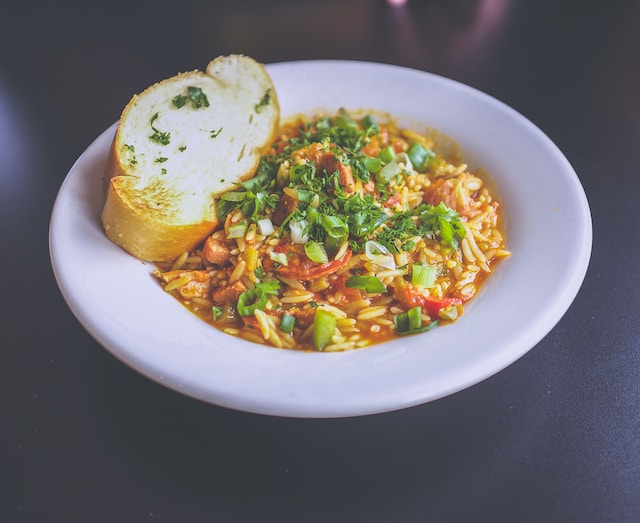Spices for rice dishes are like fairy godmothers for Cinderella. They have the power to turn something ordinary into something extraordinary. The right combination of spices can add a whole new level of depth and flavor to your rice dishes, taking your taste buds on a flavorful journey around the world. From the smoky heat of paprika to the warm sweetness of cinnamon, there is a spice or spice blend that can bring your rice dishes to life. So, if you want to make your rice dishes special, read this guide to reveal the best spices for rice dishes!
Origin of Putting Spices on Rice Dishes

Spicing up rice dishes has been a centuries-old tradition across cultures, adding depth and complexity to this staple food. Different regions have their own unique blends of spices to flavor rice, making it a delicious and flavorful dish.
✤ Indian cuisine
In India, for instance, a mixture of spices like cumin, coriander, turmeric, and garam masala is used to flavor rice-based dishes. This delightful combination, known as “pulao masala,” is added to the rice while it cooks, giving it a tantalizing aroma and taste.
✤ Middle Eastern cuisine
Middle Eastern cuisine, on the other hand, is influenced by ancient trade routes that connected the region to Asia and Europe. Here, spices such as cinnamon, cardamom, and cloves are used to season rice dishes like biryani, lending a unique and exotic flavor to this beloved dish.
✤ Latin American cuisine
In Latin America, rice dishes like arroz con pollo are flavored with a mixture of spices like cumin, oregano, and paprika. These spices are combined with other ingredients like garlic, onions, and peppers to make a mouthwatering and flavorful dish.
Throughout history, spices have played a significant role in rice dishes, giving them an added dimension of flavor and complexity. Even today, spices continue to be a vital ingredient in rice-based dishes, making them all the more irresistible and satisfying.
Health Benefits of Adding Spices to Rice Dishes

✓ Improved digestion
Spicing up your rice dish with cumin, coriander, fennel, or ginger is like giving your digestive system a high-five. These spices actively stimulate the secretion of digestive enzymes, help prevent bloating, and enhance nutrient absorption. By adding a generous sprinkle of ginger to your rice dish, you can put a pep in your digestive system’s step and kiss indigestion goodbye.
✓ Boosted immunity
Boosting your immunity is as easy as adding a pinch of turmeric, cumin, or cinnamon to your rice dish. These spices pack a punch with their anti-inflammatory properties, which work to eliminate harmful free radicals and support your body’s natural defense against infections and diseases. A dash of turmeric in your rice dish is like a superhero cape for your immune system!
✓ Lowered blood sugar levels
Cinnamon and fenugreek are like little blood sugar warriors, actively regulating your insulin sensitivity and stabilizing your blood sugar levels. Adding these spices to your rice dish is like a delicious medicine that can help promote a healthier metabolism, lower your risk of diabetes, and keep your body humming along like a well-oiled machine.
✓ Improved heart health
Garlic, ginger, and turmeric are the three musketeers of heart health. These spices actively lower blood pressure and cholesterol levels, promoting a healthier heart and reducing your risk of heart disease. By incorporating them into your rice dishes, you can give your heart a much-needed boost and savor the flavor at the same time.
✓ Increased antioxidant intake
Spices like cloves, ginger, and cinnamon are like a battalion of antioxidant superheroes, working hard to protect your body from harmful free radicals and oxidative stress. By adding these spices to your rice dishes, you can give your body a much-needed dose of antioxidants and promote overall wellness.
✓ Enhanced dish flavor
A touch of saffron, cardamom, or cumin is like a secret weapon for your rice dish, adding a burst of flavor that tantalizes your taste buds and revs up your appetite. By enhancing the flavor of your rice dish, you’re more likely to enjoy it and eat more whole grains and healthy foods, promoting a more balanced and healthier diet. So go ahead, spice it up, and enjoy the delicious benefits!
How to Choose the Right Spices for Your Rice Dishes
✱ Consider the type of rice dish
Different types of rice dishes require different types of spices. For example, biryanis are often prepared with aromatic spices like saffron, cardamom, and cloves, while fried rice may use more pungent spices like garlic and ginger. Knowing the type of rice dish you’re making will help you select the right spices that complement the other ingredients and create a cohesive flavor profile.
✱ Think about the flavor profile you want to achieve
Depending on your taste preferences, you may want to create a spicy, tangy, or sweet flavor profile. For example, cumin, coriander, and turmeric can add earthy and warm flavors, while chili powder, cinnamon, and nutmeg can add heat and sweetness. Consider the other ingredients in your rice dish, and choose spices that complement them while adding depth and complexity to the overall flavor.
✱ Be mindful of the intensity of the spices
Some spices have a milder flavor, while others are more intense. Using spices in moderation is key to ensure that they don’t overpower the other flavors in your rice dish. For example, cumin and coriander have a relatively mild flavor and can be used in larger quantities, while chili powder and black pepper have a more intense flavor and should be used sparingly.
✱ Consider the cooking method
To release their flavors, some spices require toasting or frying, while others are best added at the end of cooking. For instance, cumin and coriander seeds are usually toasted before adding to rice dishes. Additionally, whole spices like bay leaves and cinnamon sticks are added at the beginning of cooking, whereas parsley and cilantro are added at the end to maintain their freshness.
✱ Experiment and taste
Cooking is all about experimenting and finding the right balance of flavors that you enjoy. When adding spices to your rice dish, start with small amounts of each spice, taste the dish, and add more if needed. This will help you achieve the perfect balance of flavors that you’re looking for. Don’t be afraid to try new spice combinations and adjust the amounts based on your preferences until you find the perfect blend.
Dos and Don’ts When Adding Spices to Rice Dishes
☑ What to do
Do be adventurous and try out different spice blends to tantalize your taste buds. Fresh spices are the way to go if you want an explosion of flavors in your dish. Toasting whole spices before grinding them will bring out their natural oils, adding depth and complexity to your rice. Make sure to add spices to the cooking water before adding the rice, so that every grain is infused with the aromatic spices.
Taste your rice as you go, and adjust the seasoning to your liking. A pinch of sugar will balance out any fiery spices and give your rice that perfect sweet and savory balance. Remember to add your spices gradually, so as not to overwhelm the dish with too much flavor.
❌ What not to do
Don’t make the mistake of throwing all your spices in at once; this will only result in a confused and muddled flavor. Expired or stale spices will not do your dish any favors, so always go for fresh spices. Timing is everything, so avoid adding spices too early in the cooking process; otherwise, they may lose their potency.
Salt is a powerful seasoning, so be cautious and add it sparingly. Too much salt will mask the flavor of your spices and other ingredients. Finally, don’t mix incompatible spices; some spice combinations can clash and create an unpleasant taste. Follow these tips, and you’ll be on your way to creating delicious and well-spiced rice dishes!
Best Spices for Rice Dishes

◈ Cumin
Cumin is a versatile spice that works well with many different types of rice dishes. Try toasting whole cumin seeds in a dry skillet before adding them to the rice to release their full flavor. You can also combine cumin with other spices such as coriander and chili powder to create a flavorful spice blend that can be used as a rub on meats or added to soups and stews.
◈ Turmeric
Turmeric has a bright yellow color that can add a pop of color to any rice dish. You can also use turmeric to make “golden rice” by cooking the rice with turmeric, onion, and garlic. This rice is perfect for pairing with curries or other spiced dishes.
◈ Cardamom
Cardamom has a sweet and floral flavor that can add an exotic touch to rice dishes. Try adding a few whole cardamom pods to the rice while it’s cooking, or grind the pods and sprinkle the powder over the rice. You can also use cardamom in sweet rice dishes such as rice pudding.
◈ Cinnamon
Cinnamon has a warm and comforting flavor that can add a touch of sweetness to rice dishes. Try adding a cinnamon stick to the pot of rice while it’s cooking, or sprinkle cinnamon powder over the cooked rice along with some toasted nuts and dried fruit for a delicious and nutritious dessert.
◈ Cloves
Cloves have a warm and spicy flavor that can add depth to rice dishes. Try adding whole cloves to the rice while it’s cooking, or grind the cloves and mix the powder with other spices such as cumin and coriander to create a flavorful spice blend that can be used to season meats and vegetables.
◈ Coriander
Coriander has a fresh, citrusy flavor that can add brightness to rice dishes. Try toasting whole coriander seeds before adding them to the rice to bring out their full flavor. You can also use coriander in marinades for meats or salad dressings.
◈ Saffron
Saffron has a luxurious flavor that can add a touch of elegance to rice dishes. Try steeping a few strands of saffron in hot water before adding it to the rice to create a vibrant yellow color and a subtle floral flavor. You can also use saffron in desserts such as rice pudding or custard.
◈ Bay leaves
Bay leaves have a slightly bitter and herbal flavor that can add complexity to rice dishes. Try adding a few bay leaves to the pot of rice while it’s cooking, or grind the dried leaves into a powder and mix with other spices such as cumin and coriander to create a savory spice blend that can be used to season meats and vegetables.
◈ Nutmeg
Nutmeg has a warm and nutty flavor that can add a comforting touch to rice dishes. Try grating fresh nutmeg over the cooked rice along with some melted butter and Parmesan cheese for a delicious and decadent side dish.
◈ Chili powder
Chili powder has a spicy and slightly bitter flavor that can add heat to rice dishes. Try mixing chili powder with cumin and coriander to create a flavorful spice blend that can be used to season meats and vegetables. You can also sprinkle chili powder over the cooked rice, along with some chopped cilantro and lime juice, for a zesty and refreshing side dish.
Common Rice Dishes with Spices
✲ Biryani
Biryani is a vibrant and aromatic rice dish that is truly a celebration of spices. Imagine tender chunks of marinated chicken or lamb, cooked to perfection with a blend of rich spices such as cumin, coriander, turmeric, and cardamom. The rice is layered with meat and spices, creating a symphony of flavors with every bite. As you dig in, you can taste the subtle sweetness of the caramelized onions and the tangy burst of juicy tomatoes. Freshly chopped cilantro and mint leaves garnish the dish, and a cooling cucumber raita on the side balances the biryani’s spiciness perfectly.
✲ Pilaf
Pilaf is a comforting and aromatic rice dish that is perfect for chilly evenings. Imagine a blend of earthy spices such as cinnamon, cumin, and turmeric infusing fluffy grains of basmati rice. Tender chunks of lamb or chicken, cooked to perfection with spices, stud the rice. As you take a spoonful of the dish, you can taste the subtle sweetness of caramelized onions and feel the crunchy texture of toasted almonds scattered on top. Additionally, a dollop of creamy yogurt on the side adds a tangy note to the comforting flavors of the pilaf.
✲ Jambalaya
Jambalaya is a bold and spicy rice dish that is packed with flavor. Imagine succulent pieces of andouille sausage, tender chunks of chicken, and plump shrimp, all cooked to perfection in a blend of spices such as cayenne pepper, paprika, and thyme. A flavorful broth simmers the rice, which absorbs all the bold flavors of the meat and spices. As you take a bite, you can feel the spices’ heat creeping up on your taste buds, but the caramelized onions’ sweetness and the juicy tomatoes’ acidity perfectly balance the dish. Furthermore, freshly chopped parsley garnishes the dish, and it is served with a side of buttery cornbread.
✲ Paella
Paella is a vibrant and colorful rice dish that is perfect for sharing with friends and family. Imagine a luscious blend of tender chicken, juicy shrimp, and meaty mussels, all cooked to perfection with a blend of spices such as garlic, paprika, and rosemary. A fragrant broth is used to cook the rice. Saffron is infused to give the dish its distinctive yellow color and delicate flavor. As you dig in, you taste the smoky flavors of the chorizo and sweet peppers adding depth to the dish. The paella is garnished with freshly chopped parsley and served with a side of crusty bread.
✲ Pulao
Pulao is a fragrant and aromatic rice dish that is perfect for special occasions. Imagine perfectly cooked tender chunks of lamb or beef with a spice blend including cumin, coriander, and cardamom. A flavorful broth is used to simmer the rice. Bay leaves and cinnamon are infused to add a subtle sweetness to the dish. The pulao has earthy flavors from caramelized onions. Each spoonful of the dish tastes a burst of sweetness added by raisins. Additionally, freshly chopped mint and cilantro leaves garnish the pulao, and a side of tangy mango chutney accompanies it.
✲ Fried Rice
Fried rice is a popular dish in many Asian cuisines. One usually stir-fries a variety of spices, such as soy sauce, ginger, and garlic with leftover cooked rice to make it. It can contain meat, vegetables, or both, and is often served as a side dish or a main course.
Final Words
In conclusion, spices are the magical ingredients that can transform a simple bowl of rice into a flavor-packed and unforgettable culinary experience. Spices or spice blends can elevate your rice dishes to new heights. You can choose from chili powder, cinnamon, cumin, or turmeric to add heat, sweetness, warmth, or richness. And the best part? You don’t have to be a professional chef or a spice connoisseur to experiment with spices in your rice dishes. Just start with a pinch of this and a dash of that, and let your taste buds guide you on a culinary journey that is as delicious as it is adventurous.
So, the next time you cook rice, don’t settle for plain and boring. Experiment with spices and see how they can add depth, complexity, and excitement to your meals. Whether you’re cooking for yourself, your family, or your friends, you can always make your rice dishes more flavorful and memorable with the right combination of spices. So, go ahead, spice up your life and your rice!
